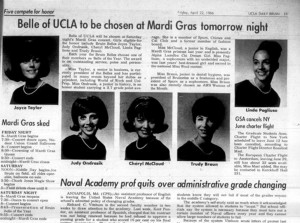The glittery masquerade balls, spicy cajun food and rollicking jazz music of Mardi Gras have been absent from the UCLA Intramural Field.
But it was not always this way. From 1945 to 1995, Mardi Gras at UCLA was celebrated with a three-day long festival, where booths run by clubs and Greek chapters served corn dogs and teriyaki bowls to crowds from all over Los Angeles county. Mayors and celebrities joined suburban families to watch culturally themed skits showcasing UCLA students’ skills in singing, acting and dancing.
“Mardi Gras was one of the great community engagement projects. It was a unifying element of the students, not just the Greek community,” said Randy Sheinbein, co-chairman of the 1977 student-run Mardi Gras committee.
Students applied to be a part of a two-quarter long class where a Mardi Gras committee was formed. Sheinbein said each student was eager to influence the festival, with visions for spinning carousels and soaring Ferris wheels.
In 1977, an alumna pitched Sheinbein a design portfolio of ideas to advertise on Los Angeles city buses and on freeway billboards. After two quarters of working together on the festival’s PR campaign, designing advertisements and rallying student support, the two fell in love.
“That girl ended up being my wife,” Sheinbein said.
However, the romance of the festival didn’t last, the UCLA Mardi Gras festival changed May 19, 1991. The Los Angeles Times reported that more than 500 festival-goers smashed windows and looted stores throughout Westwood after being evicted by UCLA Mardi Gras security.

The Los Angeles Police Department and surrounding community then forced the Mardi Gras committee to restrict festival hours from a midnight curfew to 7 p.m.
Former Mardi Gras event manager and alumnus David Lowenstein said the restrictive hours caused the festival’s quality and appeal to decrease. Lowenstein said organizing and promoting a modern Mardi Gras today with the breadth and ambition of previous decades would be impossible. In the late 1980s, the festival netted about $200,000 for charity, but went $20,000 into the red in the early 1990s.
Beginning in 1992, three more attempts were made to continue Mardi Gras with more restrictive hours and a more friendly atmosphere. But the festival’s reserve fund was eventually depleted, forcing the event to end in 1995.
Sheinbein said because of the elimination of the joyful crowds and engaging skits, there was a sense of tremendous loss on the UCLA campus. Mardi Gras, he said, was UCLA’s greatest opportunity for engagement with Los Angeles, and no event exists that could take its place.
For now, Fat Tuesday remains without any student-motivated unity through fashion or food like the Mardi Gras festival of the past. However, only jazz group Bernstein, Butler and the Hot 9 along with Indian rock ensemble Red Baraat will be performing at Royce Hall Tuesday in celebration of Mardi Gras.
Bernstein, Butler and the Hot 9 lead pianist Henry Butler, expressed a disappointed sentiment at the lack of on-campus Mardi Gras events. Butler said Mardi Gras is the last day of fun before the season of Lent, and it’s a shame that UCLA students can’t experience the jubilant parties and festive atmosphere common in his hometown of New Orleans, the epicenter of Mardi Gras festivities.
“There are beautiful outfits, lavish dresses, great-looking suits, great cooking and great music,” Butler said. “It would be nice to have something like that in Westwood.”
Third-year materials science and engineering student Rogerio Zulzke Pompermayer said UCLA is missing out on an opportunity for students to represent their cultures, just as they do during the Mardi Gras festival in his native Brazil.
“There is a lack of cultural expression here,” Zulzke Pompermayer said. “Mardi Gras is about people with different cultures coming together and it’s a shame UCLA doesn’t celebrate that.”
Even though the campus festivities are over, the nostalgia for Mardi Gras remains with those who worked on the UCLA festival. For Sheinbein, Mardi Gras will always be remembered as the event that brought him to UCLA, and to his wife. Sheinbein misses the hard work and the feeling of on-campus community that resulted from organizing and implementing the festival.
“We physically built Mardi Gras – everyone had a responsibility,” Sheinbein said. “The reality was everyone had a lot of fun.”

Amazing you didn’t see the link between this :”In 1977, an alumna pitched Sheinbein a design portfolio of ideas to advertise on Los Angeles city buses and on freeway billboards.” and this ” However, the romance of the festival didn’t last, the UCLA Mardi Gras festival changed May 19, 1991. The Los Angeles Times reported that more than 500 festival-goers smashed windows and looted stores throughout Westwood after being evicted by UCLA Mardi Gras security.” Instead of keeping Mardi Gras a local event, you morons advertised all over LA and brought in the gangs.